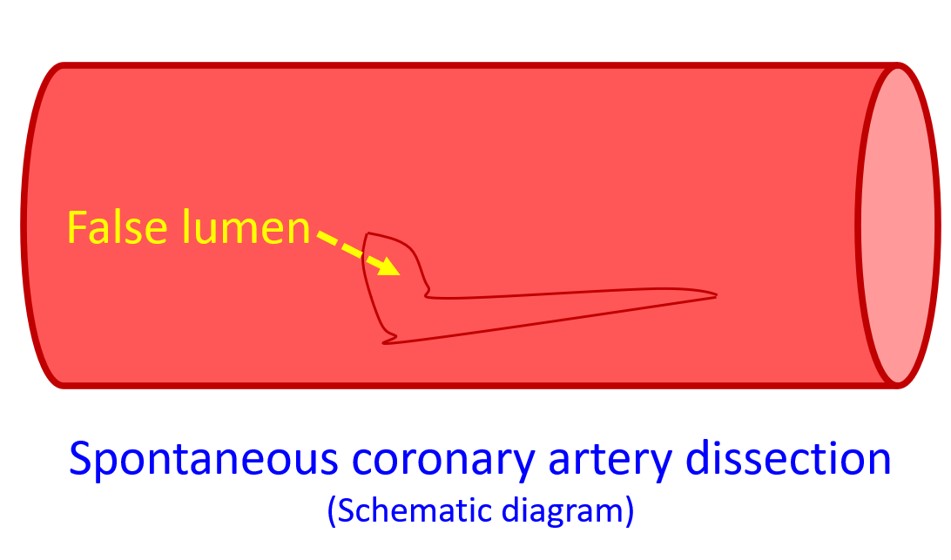Spontaneous coronary artery dissection (SCAD)
Spontaneous coronary artery dissection (SCAD)
Spontaneous coronary artery dissection (SCAD) is an important, though rare cause of acute coronary syndrome. Management of SCAD is different from that of acute coronary syndrome due to atherosclerosis [1]. High index of suspicion is required for the diagnosis of SCAD in young patients with acute coronary syndrome. Unlike atherosclerotic coronary artery disease, management of SCAD is mostly medical, in stable patients. Revascularization is considered only in high risk patients with left main dissection, ongoing ischemia, severely limited flow, hemodynamic compromise or refractory cardiac arrhythmia [2].

It has been mentioned that only 10% of cases occur in men, often following a physical cause like exercise or lifting heavy objects. In general, SCAD may contribute from 1 to 4% of cases of acute coronary syndrome. Percentage will be higher, of the order of 15 to 20% in peripartum acute coronary syndrome. Prevalence of up to 35% among acute coronary syndrome in women below the age of 60 years has been reported [2].
A large series of 327 patients with SCAD has been reported from Canada [3]. 90.5% were women in this prospectively followed cohort. All had presented with myocardial infarction, of which 25.7% had ST elevation myocardial infarction while 74.3% had non ST segment elevation myocardial infarction. Presentation with ventricular tachycardia or fibrillation was noted in 8.9%. Emotional stress was noted in 48.3% and physical stress in 28.1% as potential precipitating factors.
Fibromuscular dysplasia was present in 62.7% and systemic inflammatory disease in 11.9%. Connective tissue disorder was noted in 4.9%. Only 16.5% were treated with percutaneous coronary interventions and 2.2% with coronary artery bypass graft surgery. 83.1% were treated medically initially. Overall major adverse event rate was 7.3% in the hospital. At a median follow up of 3.1 years, death rate was 1.2%, recurrent myocardial infarction 16.8% and stroke or transient ischemic attacks 1.2%. Recurrence of SCAD occurred in 10.4%. Beta-blocker use diminished the risk of recurrent SCAD while hypertension increased the risk [3].
Another nationwide readmission database study had 1,386 patients over a 5 year period, which constituted 0.052% of more than 2.6 million admissions with acute myocardial infarction. Readmission rate was higher with SCAD, 12.3% vs 9.9%. 80.6% of the readmissions were for a cardiac cause, 44.8% being due to acute myocardial infarction, 20.1% due to chest pain and 12.7% with arrhythmia. Over 50% of the readmissions were within one week of discharge [4].
Important aspects in long term management of SCAD are screening for fibromuscular dysplasia and other disorders of blood vessel walls, monitoring for recurrence and cardiac rehabilitation in general [2].
References
- Adlam D, Tweet MS, Gulati R, Kotecha D, Rao P, Moss AJ, Hayes SN. Spontaneous Coronary Artery Dissection: Pitfalls of Angiographic Diagnosis and an Approach to Ambiguous Cases. JACC Cardiovasc Interv. 2021 Aug 23;14(16):1743-1756. doi: 10.1016/j.jcin.2021.06.027. PMID: 34412792; PMCID: PMC8383825.
- Pristera N, Chaudhury P, Van Iterson EH, Cho LS. Spontaneous coronary artery dissection: Principles of management. Cleve Clin J Med. 2021 Nov 2;88(11):623-630. doi: 10.3949/ccjm.88a.20162. PMID: 34728488.
- Saw J, Humphries K, Aymong E, Sedlak T, Prakash R, Starovoytov A, Mancini GBJ. Spontaneous Coronary Artery Dissection: Clinical Outcomes and Risk of Recurrence. J Am Coll Cardiol. 2017 Aug 29;70(9):1148-1158. doi: 10.1016/j.jacc.2017.06.053. PMID: 28838364.
- Gad MM, Mahmoud AN, Saad AM, Bazarbashi N, Ahuja KR, Karrthik AK, Elgendy IY, Elgendy AY, Don CW, Hira RS, Massoomi MR, Saw J, Anderson RD, Kapadia SR. Incidence, Clinical Presentation, and Causes of 30-Day Readmission Following Hospitalization With Spontaneous Coronary Artery Dissection. JACC Cardiovasc Interv. 2020 Apr 27;13(8):921-932. doi: 10.1016/j.jcin.2019.12.033. PMID: 32327089.


